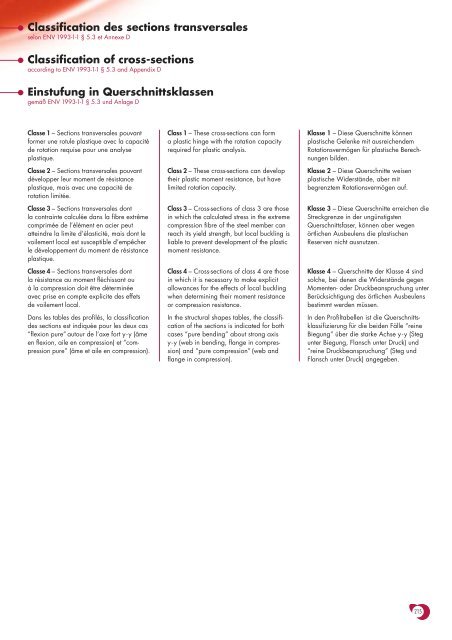teknik.pdf
teknik.pdf
teknik.pdf
Create successful ePaper yourself
Turn your PDF publications into a flip-book with our unique Google optimized e-Paper software.
Classification des sections transversalesselon ENV 1993-1-1 § 5.3 et Annexe DClassification of cross-sectionsaccording to ENV 1993-1-1 § 5.3 and Appendix DEinstufung in Querschnittsklassengemäß ENV 1993-1-1 § 5.3 und Anlage DClasse 1 – Sections transversales pouvantformer une rotule plastique avec la capacitéde rotation requise pour une analyseplastique.Classe 2 – Sections transversales pouvantdévelopper leur moment de résistanceplastique, mais avec une capacité derotation limitée.Classe 3 – Sections transversales dontla contrainte calculée dans la fibre extrêmecomprimée de l’élément en acier peutatteindre la limite d’élasticité, mais dont levoilement local est susceptible d’empêcherle développement du moment de résistanceplastique.Classe 4 – Sections transversales dontla résistance au moment fléchissant ouà la compression doit être déterminéeavec prise en compte explicite des effetsde voilement local.Dans les tables des profilés, la classificationdes sections est indiquée pour les deux cas“flexion pure” autour de l’axe fort y-y (âmeen flexion, aile en compression) et “compressionpure” (âme et aile en compression).Class 1 – These cross-sections can forma plastic hinge with the rotation capacityrequired for plastic analysis.Class 2 – These cross-sections can developtheir plastic moment resistance, but havelimited rotation capacity.Class 3 – Cross-sections of class 3 are thosein which the calculated stress in the extremecompression fibre of the steel member canreach its yield strength, but local buckling isliable to prevent development of the plasticmoment resistance.Class 4 – Cross-sections of class 4 are thosein which it is necessary to make explicitallowances for the effects of local bucklingwhen determining their moment resistanceor compression resistance.In the structural shapes tables, the classificationof the sections is indicated for bothcases “pure bending” about strong axisy-y (web in bending, flange in compression)and “pure compression” (web andflange in compression).Klasse 1 – Diese Querschnitte könnenplastische Gelenke mit ausreichendemRotationsvermögen für plastische Berechnungenbilden.Klasse 2 – Diese Querschnitte weisenplastische Widerstände, aber mitbegrenztem Rotationsvermögen auf.Klasse 3 – Diese Querschnitte erreichen dieStreckgrenze in der ungünstigstenQuerschnittsfaser, können aber wegenörtlichen Ausbeulens die plastischenReserven nicht ausnutzen.Klasse 4 – Querschnitte der Klasse 4 sindsolche, bei denen die Widerstände gegenMomenten- oder Druckbeanspruchung unterBerücksichtigung des örtlichen Ausbeulensbestimmt werden müssen.In den Profiltabellen ist die Querschnittsklassifizierungfür die beiden Fälle “reineBiegung” über die starke Achse y-y (Stegunter Biegung, Flansch unter Druck) und“reine Druckbeanspruchung” (Steg undFlansch unter Druck) angegeben.215


